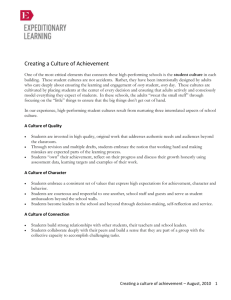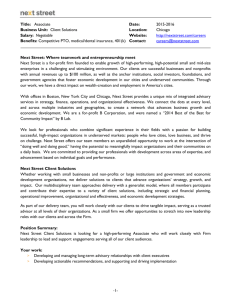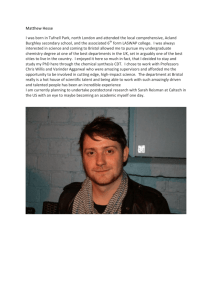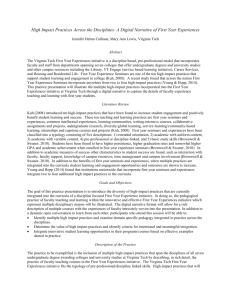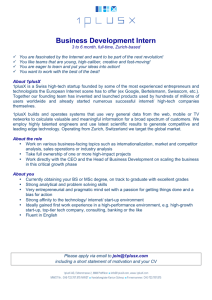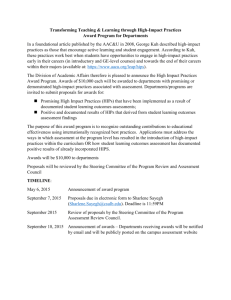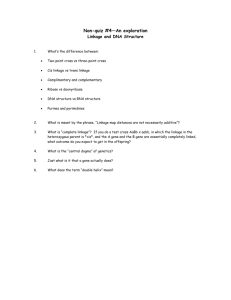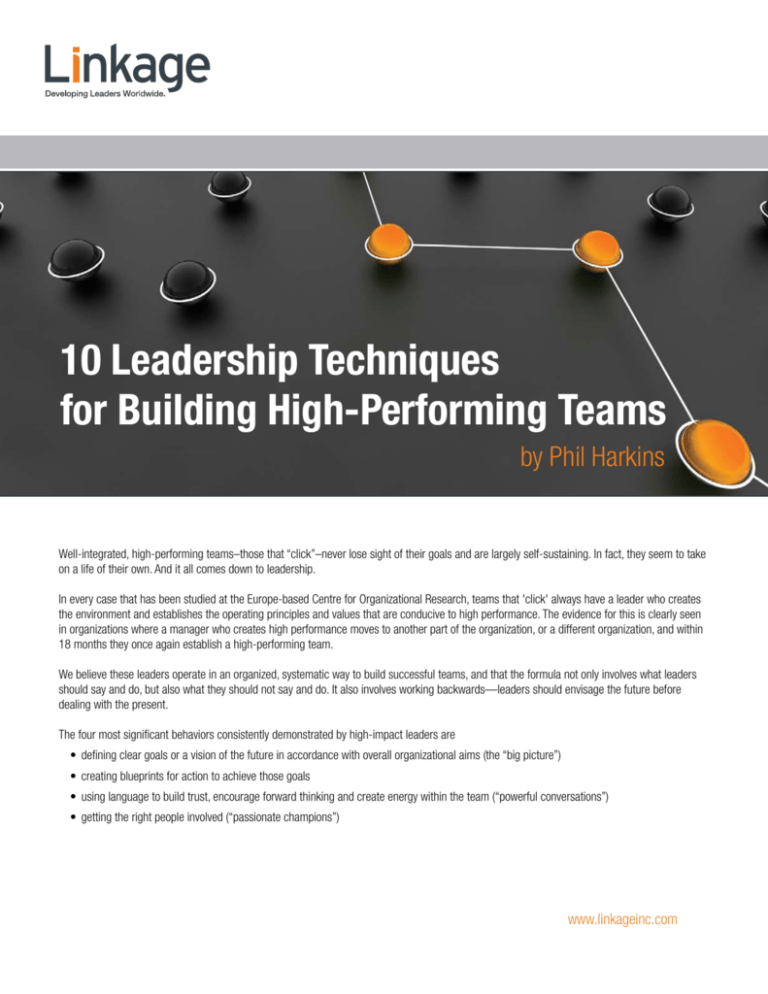
10 Leadership Techniques
for Building High-Performing Teams
by Phil Harkins
Well-integrated, high-performing teams–those that “click”–never lose sight of their goals and are largely self-sustaining. In fact, they seem to take
on a life of their own. And it all comes down to leadership.
In every case that has been studied at the Europe-based Centre for Organizational Research, teams that 'click' always have a leader who creates
the environment and establishes the operating principles and values that are conducive to high performance. The evidence for this is clearly seen
in organizations where a manager who creates high performance moves to another part of the organization, or a different organization, and within
18 months they once again establish a high-performing team.
We believe these leaders operate in an organized, systematic way to build successful teams, and that the formula not only involves what leaders
should say and do, but also what they should not say and do. It also involves working backwards—leaders should envisage the future before
dealing with the present.
The four most significant behaviors consistently demonstrated by high-impact leaders are
• defining clear goals or a vision of the future in accordance with overall organizational aims (the “big picture”)
• creating blueprints for action to achieve those goals
• using language to build trust, encourage forward thinking and create energy within the team (“powerful conversations”)
• getting the right people involved (“passionate champions”)
www.linkageinc.com
10 LEADERSHIP TECHNIQUES FOR BUILDING HIGH-PERFORMING TEAMS
Imparting a clear vision of where the team should be headed, and inspiring its members to make it a reality, is
fundamental to team success. The great American tennis player Arthur Ashe had a wonderful phrase: "I never
worried about winning or losing. I just went for it every time." Leaders who get teams to click consistently have
their members tied together and "going for it."
This takes considerable effort on the part of a leader, so it's useful to reflect on why it's worthwhile. As the English
manager in a large aerospace company explained to me, "It's a lot of work to get a team to click. It's a lot more
work to live with a team that isn't clicking." It's as if successful team leaders calculate the up-front investment
and then adopt a process to get the team to pull together to maximize the return on that investment.
Here is what high-impact leaders do. They create a clear vision and describe it in simple language. They take the
time to get people to subscribe, or buy in, to that vision. Next, they assess the current situation, then work through
the courses of action which are likely to yield results. It is the up-front work in getting to a clear end state that
makes the process work.
This foundation-laying aspect of leadership is a determining factor in why some teams seem to grasp and then
do their utmost to achieve organizational goals. It's all about how the leader continually visualizes a positive end
result. So, when things get tough for the team (as they always do), these extraordinary leaders reintroduce the
big picture with phrases like: "Remember our objectives," and "Let's keep our eye on the ball." This consistent
single strategy of starting with the future and then moving back to the present allows leaders to make the tough
decisions which enable the team to recognize and articulate problems ("What's really up?" or "What's really so?"),
sort through possible solutions, and then take action.
PHIL HARKINS
PHIL HARKINS is the Founder & Executive Chairman of Linkage. He is an
internationally known expert in the fields of organization development,
leadership, communications, and executive coaching. His clients include senior
executives and teams at leading organizations worldwide.
Phil has worked with leaders, leadership teams, and boards in more than
25 countries located in Asia, North America, South America, Europe, and the
Middle East. Along with leadership expert and Linkage board member Warren Bennis, Phil is co-chair of
Linkage's Global Institute for Leadership Development ™, a five-day program for leaders and leadership
teams that provides accelerated, transformational leadership growth.
Phil has authored and edited several books, including the forthcoming Don’t Settle and In Search of
Leadership: How Great Leaders Answer the Question "Why Lead?" (with Phil Swift; McGraw-Hill, 2009);
Everybody Wins: The Story and Lessons Behind RE/MAX (John Wiley & Sons, 2004); The Art and Practice
of Leadership Coaching (John Wiley & Sons, 2004); and Powerful Conversations: How High-Impact Leaders
Communicate (McGraw-Hill, 1999). He has spoken on these and other topics at more than 400 conferences,
seminars, and programs around the globe.
Copyright © 2014 Linkage. All Rights Reserved.
www.linkageinc.com
10 LEADERSHIP TECHNIQUES FOR BUILDING HIGH-PERFORMING TEAMS
Teams that consistently don’t “get it together” over a long period of time can put up tough opposition for leaders who
want to move forward. We like to say that such teams get “caught in the swamp.” Unfortunately, what they also do is
pull others into the swamp with them.
From extensive research, we conclude that extraordinary leaders employ distinctive forms of verbal communication.
It is what these leaders say and what they don’t say that gives them an advantage in getting teams to highperformance levels. These leaders truly mean what they say. They don’t mix their messages, fudge meanings or use
ambiguous words. Their conversations are always candid, clear, and followed by committed action.
We call them “powerful conversations,” because they make blueprints come alive and create positive attitudes and
energy on the part of team members. They also encourage mutual understanding between team members and the
leader; use language to make a vision seem real and worth attaining. A “powerful conversation” typically progresses in four stages.
STAGE 1:
Before getting into the specific details of goals and objectives, high-impact leaders spend
all the time that’s needed on forming a clear vision (e.g., the general shape of a desired
outcome or future state) which makes possible complete, undisputed acceptance of its attainability.
STAGE 2:
This entails a very candid and clear discussion of what people are thinking and feeling. The high-impact leader makes sure that everyone’s agenda is heard and explored. He or
she carefully asks questions to make sure there is a genuine expression of beliefs, expectations and even fears, while
also patiently ensuring that the conversation remains relevant to the big picture. This keeps all those involved out
of the swamp, and enables them to set up a useful and realistic agenda. Once this is done, the high-impact leader
assesses the agenda.
STAGE 3:
The high-impact leader now skillfully discusses with team members the issues
enmeshed in their proposed agenda. In this way, the leader can deepen his or her
understanding of the team’s goals and bring to the surface any hidden agendas. The high-impact leader describes
scenarios linking future outcomes with the current situation, then proceeds to refine them. He or she continues
to keep the process focused on the target future state, and helps the team to see how far it has moved and what
progress it has made.
STAGE 4:
The leader makes sure participants know exactly what steps need to be taken next, and
that they are open about what they will do to turn their commitments into reality–making
the team “alive.” The closing of a powerful conversation is also the time when a leader makes sure there is absolute
buy-in, or belief in what the team is setting out to do, that team members’ commitments are clear and accepted,
that all action steps are well-defined and understood. In this way, the high-impact leader ensures that the powerful
conversation will produce results.
These are the four most significant behaviors consistently demonstrated by high-impact leaders. But they are not
the only such behaviors. What follows is a less detailed but fuller list of what leaders should do to get people to work
together to attain organizational goals.
Copyright © 2014 Linkage. All Rights Reserved.
www.linkageinc.com
10 LEADERSHIP TECHNIQUES FOR BUILDING HIGH-PERFORMING TEAMS
1
Define a very clear picture of the future–a vision for the team. This is crucial, because teams search
desperately for specific targets. Consider the old expression: “If you don’t know where you are going, any
road will get you there.” Journeys without a clear destination leave groups feeling flat and lost. Keeping teams
informed on where they’re headed and how best to get there means leaders must be prepared to acknowledge and
adapt to changes in operational conditions and even objectives. Leaders cannot sit back and watch, but instead must
create and recreate the vision and team spirit that stops people from losing heart and becoming lost.
2
Be genuine, even if it means lowering your guard. Leaders who create “click” have an uncanny sense
about how and when to express their inner selves. They will even reveal their own vulnerabilities at the right
time to gain the respect of those around them. They are not so concerned about projecting a perfect image:
they know that high-impact leaders get results by laughing at their own flaws. They don’t play make-believe, knowing
it’s more important “to be” than to “seem to be.”
3
Ask good questions. They use inquiry and advocacy in such a way as to keep them abreast of what is really
going on. They seem to use a simple formula of the 70-20-10 rule in conversations: 70 percent listening,
20 percent enquiring with just the right amount of advocacy, and 10 percent tracking (i.e., summarizing and
synthesizing information, and providing possible courses of action).
4
Talk about things–even the hard things. A leader who gets their team to click is not afraid to talk about
the tough stuff. They find ways to have the difficult conversations in the knowledge that burying problems
doesn’t make them go away. They also know that if they, as leader, don’t talk about things, no-one will
and, pretty soon, a culture will develop in which too many things are left unsaid. (I can always tell when teams are
dysfunctional by measuring the amount of stuff not talked about, or what I call the “let’s not go there” issues.)
5
Follow through on commitments. Leaders of high-performing teams find ways to build trust and maintain
it, especially by making teams hold to their commitments and keeping the team’s view of its goals clear.
However, they also know how to distinguish professional trust from blind loyalty.
6
Let others speak first. In high-performing teams, members see themselves as equal in terms of
communication. Leaders should therefore encourage this by putting the other person’s need to express his or
her agenda ahead of their own.
7
Listen. High-performing teams are comprised of people who have mastered the art of listening without fear,
of allowing others to speak without reacting strongly or negatively to what is being said, or what they anticipate
will be said. The leader fosters and honors this attribute within the team by quickly putting a stop to bad
conversational behavior that cuts other people off and implies that their ideas are not valued. The leader knows that
achieving higher levels of innovation requires team members to be unafraid to express unusual ideas and advocate
experimental processes. They emphasize this by publicly thanking those who take risks–and by making sure that
sharpshooters put their guns away.
Copyright © 2014 Linkage. All Rights Reserved.
www.linkageinc.com
10 LEADERSHIP TECHNIQUES FOR BUILDING HIGH-PERFORMING TEAMS
8
Face up to non-performing players. This brings us to a very important characteristic of highperforming teams, which is that their leaders do not tolerate players who pull the team apart. Interestingly,
experienced leaders frequently maintain unity and discipline through third parties in the form of people we
call “passionate champions.” A leader may surround him- or herself with several passionate champions, who have
established an understanding and close working relationship with one another, and who are totally focused on, and
committed to, the team’s objectives. They are capable of getting the job done–and not afraid to remove people who
are failing to help them do so.
9
Have fun, but never at others’ expense. High-impact leaders steer clear of sarcasm: they always take
the high road. If they poke fun at someone, it’s usually themselves. They have learned the lesson that
reckless humor can be misinterpreted and backfire. They know that critics of the organization can turn
inappropriate remarks back on a leader who makes them.
10
Be confident and dependable. Somehow, over and above the daily struggle, leaders who get
teams to click project confidence. They do this by preparing their conversations and not backing
away from, or skimming over, real issues and problems, even difficult or confrontational ones. They
always address “What’s up?” and “What’s so?” in the organization. They don’t try to be spin doctors because they
know that, ultimately, this doesn’t work. Rather, they are known as straight shooters–people who play hard, fight
fair, and never, never give up. At the end of the day, team members know that, whatever happens, their leader will
be left standing. This gives them confidence that they will be standing, too. They also know that, should things get
really bad, their leader will not desert them or try to shift the blame, but seek to protect them, even if it means
standing in the line of fire.
TO LEARN MORE
200 Wheeler Road
Burlington, MA 01803
Linkage works with leaders and leadership teams worldwide to build organizations that produce superior results. For over
25 years, we have delivered on this promise by strategically aligning leadership, talent, and culture within organizations
globally. We do this by providing strategic consulting on leadership development and talent management topics and through
our learning institutes, skill-building workshops, tailored assessment services, and executive coaching.
Linkage is headquartered in Burlington, Massachusetts, with operations in Atlanta, New York, San Francisco, and St. Louis,
and outside the U.S. in Athens, Bangalore, Brussels, Bucharest, Buenos Aires, Hong Kong, Istanbul, Kuala Lumpur,
Kuwait City, Mexico City, Seoul, Shanghai, Singapore, and Sydney.
+1.781.402.5555
info@linkageinc.com
www.linkageinc.com
www.linkageinc.com/linkedin
www.linkageinc.com/facebook
www.linkageinc.com/twitter


